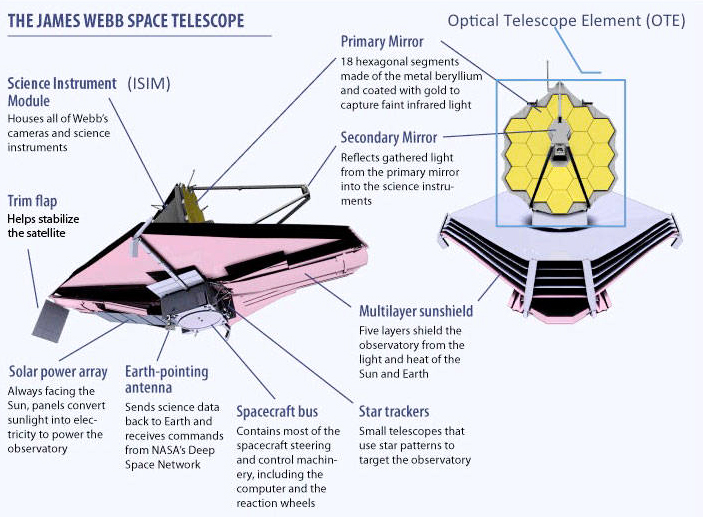James Webb Space Telescope
Why in News
The James Webb Space Telescope (JWST) is scheduled to be rocketed into orbit later this year (2021).
Key Points
- About:
- It is the most powerful infrared telescope of National Aeronautics and Space Administration (NASA).
- It is also considered a successor of the Hubble Telescope and will extend and complement its discoveries.
- Launched into low Earth orbit in 1990, the Hubble Space Telescope has made more than 1.4 million observations, including tracking interstellar objects, capturing a comet colliding with Jupiter, and discovering moons around Pluto.
- Hubble has captured galaxies merging, probed supermassive black holes and has helped us understand the history of our universe.
- The telescope is the result of an international collaboration between NASA, the European Space Agency (ESA) and the Canadian Space Agency.
- Webb will reveal new and unexpected discoveries, and help humanity understand the origins of the universe and our place in it.
- The telescope will study the atmospheres of a wide diversity of exoplanets.
- It will also search for atmospheres similar to Earth’s, and for the signatures of key substances such as methane, water, oxygen, carbon dioxide, and complex organic molecules, in hopes of finding the building blocks of life.

- Launch:
- It will be launched on an Ariane 5 ECA rocket from French Guiana in South America.
- The Ariane 5 is believed to be one of the most reliable launch vehicles.
- It will be launched on an Ariane 5 ECA rocket from French Guiana in South America.
- Goal:
- To search for the first galaxies that formed after the Big Bang.
- To determine how galaxies evolved from their earlier formation until now.
- To observe the formation of stars from the first stages to the formation of planetary systems.
- To measure the physical and chemical properties of planetary systems and investigate the potential for life in such systems.
- Webb Vs Hubble Telescope:
- Wavelength:
- The JWST will observe primarily in the infrared range and provide coverage from 0.6 to 28 microns.
- The instruments on Hubble see mainly in the ultraviolet and visible part of the spectrum. It could observe only a small range in the infrared from 0.8 to 2.5 microns.
- The infrared region of the electromagnetic spectrum covers the wavelength range from approximately 0.7 to a few 100 microns.
- Size:
- Webb’s primary mirror has a diameter of 6.5 metres while Hubble’s mirror was much smaller – 2.4 metres in diameter.
- So, Webb will have a larger field of view compared to the camera on Hubble.
- Webb also carries a large sun shield.
- Webb’s primary mirror has a diameter of 6.5 metres while Hubble’s mirror was much smaller – 2.4 metres in diameter.
- Distance:
- Webb’s near- and mid-infrared instruments will help study the first formed galaxies, exoplanets and birth of stars.
- Hubble can see the equivalent of “toddler galaxies” while Webb Telescope will be able to see “baby galaxies”.
- Webb’s near- and mid-infrared instruments will help study the first formed galaxies, exoplanets and birth of stars.
- Wavelength:
- Other Major Infrared Telescope:
- Herschel Space Observatory Telescope: It is an infrared telescope, launched in 2009 by the European Space Agency.
- It also orbits the Sun similar to how Webb would. The primary difference between Webb and Herschel is the wavelength range: Webb goes from 0.6 to 28 microns, while Herschel covers 60 to 500 microns.
- Herschel’s mirror is smaller than Webb’s. It is 3.5 metres in diameter, while Webb’s primary mirror has a diameter of 6.5 metres.
- Herschel Space Observatory Telescope: It is an infrared telescope, launched in 2009 by the European Space Agency.